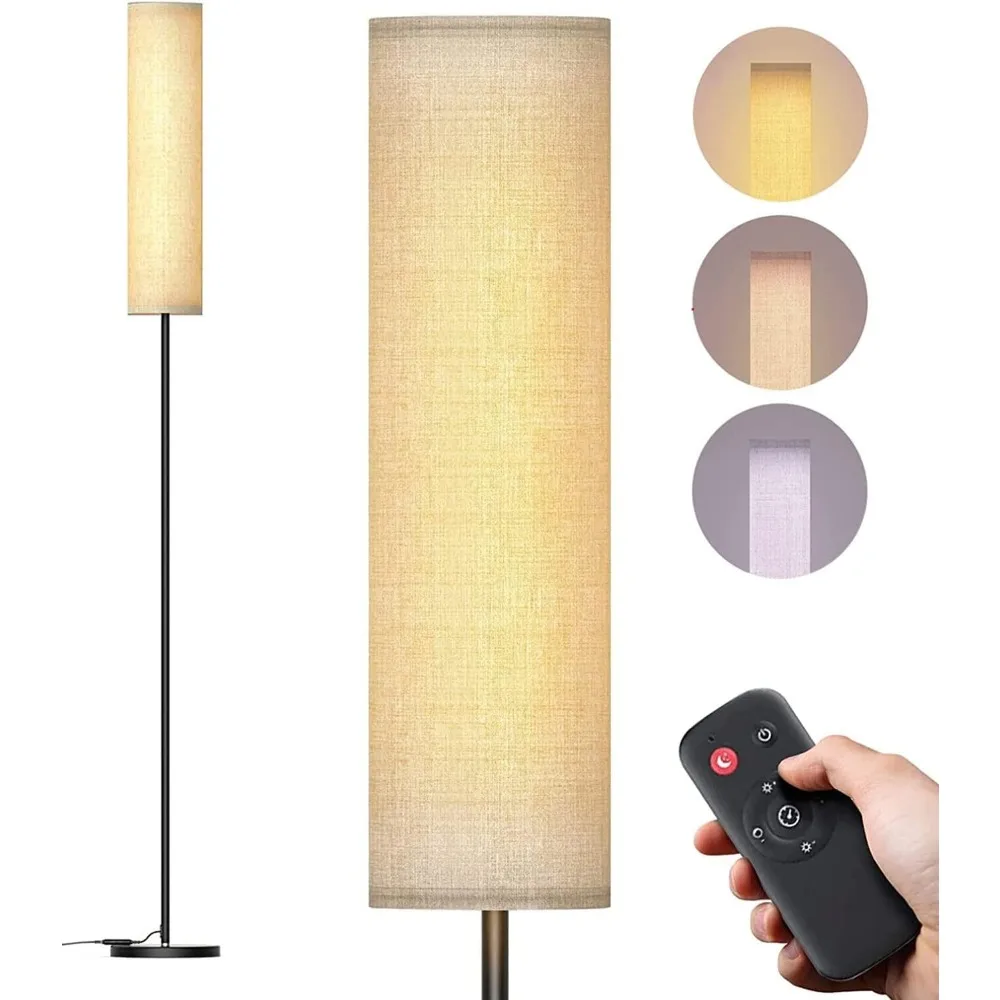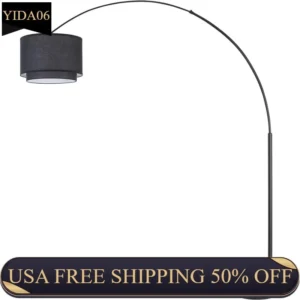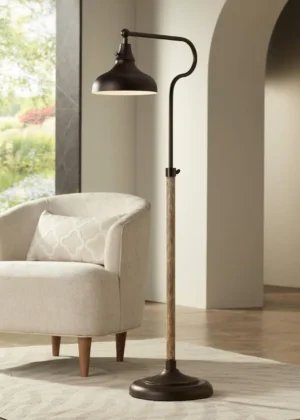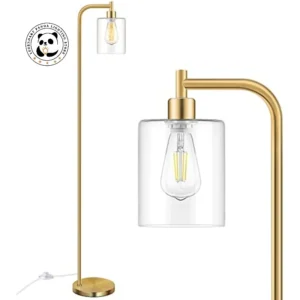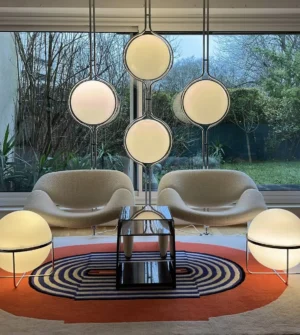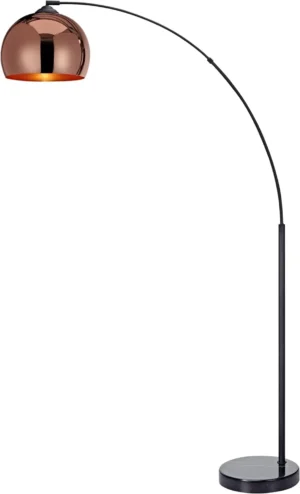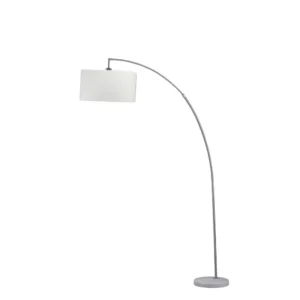Why Arc Lamps Need Heavy Bases
Arc floor lamps create a dramatic visual statement in any room with their graceful curves and overhanging design. However, this striking aesthetic comes with an inherent challenge: stability. Unlike traditional floor lamps that distribute weight vertically, arc lamps extend outward, creating an imbalance that requires careful counterweighting.
The distinctive cantilevered design of arc lamps—where the light source extends horizontally away from the supporting stand—creates a natural tipping hazard. This is basic physics at work. When weight extends away from a central support, it creates leverage that can easily topple the entire structure without proper counterbalancing.
Understanding the physics behind arc lamp stability involves three key concepts:
- Leverage – The horizontal arm multiplies the effective weight of the lamp head
- Center of gravity – The lamp’s weight distribution must be balanced to prevent tipping
- Torque – The rotational force created by the extended arm must be counteracted
Most arc lamps stand between 60-80 inches (152-203 cm) tall with horizontal reaches of 20-30 inches (51-76 cm). This design creates significant leverage against the base, similar to how a fishing rod bends under the weight of a catch or how construction cranes require massive counterweights to balance their loads.
This structural reality directly connects to safety concerns. An unstable arc lamp poses genuine risks in home environments—from property damage to potential injury, especially in households with children, pets, or high-traffic areas. The foundational information about arc lamp bases reveals why manufacturers must incorporate substantial weight into their designs.
The stability challenge explains why you’ll notice significant differences between arc lamps and traditional floor lamps when shopping, particularly in the size and weight of their bases. Understanding various arc lamp base designs helps you make informed decisions about which options provide the stability your space requires.
Design Physics: The Cantilever Challenge
Arc lamps embody the cantilever principle—a design element where a beam or structure extends horizontally and is supported only on one end. This elegant engineering approach creates the lamp’s distinctive aesthetic but introduces complex physics challenges that directly impact stability and safety.
The overhanging arm creates leverage that actively works against stability. As a physics principle, the farther the lamp head extends from the vertical support, the more force it exerts on the base. This relationship isn’t linear—it’s exponential. Doubling the horizontal reach can quadruple the tipping force.
This relationship can be expressed in a simplified formula:
Required counterweight = (Weight of lamp head × Horizontal distance) ÷ Base footprint
This explains why arc lamps with longer reaches require disproportionately heavier bases. As a general rule, many lamp designers follow a ratio of approximately 1 pound of base weight for every 6 inches (15 cm) of lamp height, with additional weight added for extended horizontal reaches.
The center of gravity calculation becomes particularly important in arc lamp design. For stability, the combined center of gravity of the entire lamp must fall within the base’s footprint. As the arm extends outward, the center of gravity shifts in that direction, requiring substantial counterweight to bring it back within the stable zone.
These physical principles explain why many high-quality arc lamps feature marble base designs that combine aesthetic appeal with necessary weight. The substantial mass of materials like marble, concrete, or cast iron isn’t just a design choice—it’s a physics requirement that ensures your lamp remains upright and safe.
Understanding these principles helps explain why quality arc lamps often command higher prices—substantial base materials add both production costs and shipping weight but are essential for proper function and safety.
Safety Considerations for Arc Lamp Stability
Inadequately weighted arc lamps create genuine safety risks that extend beyond mere inconvenience. A tipping lamp can cause significant property damage, electrical hazards, and even personal injury. Understanding these risks helps emphasize why proper weighting isn’t optional—it’s essential.
The consequences of an unstable arc lamp can include:
- Personal injuries from direct impact with falling lamp components
- Electrical fires if wiring is damaged during a fall
- Property damage to furniture, electronics, or decorative items
- Broken bulbs creating sharp glass hazards
- Potential burns from exposed hot bulbs after a fall
These risks magnify in homes with children or pets. Children may pull on cords, bump into lamp bases, or otherwise interact with lamps in ways that test their stability. Similarly, pets moving quickly through a room or playing near a lamp can create tipping hazards that might not be apparent to the average consumer.
According to industry sources, floor lamps are involved in thousands of household accidents annually, with top-heavy designs like arc lamps presenting particular concerns. Businesses face additional liability considerations when selecting lighting for commercial spaces, making proper stability essential for both safety and legal compliance.
Beyond the immediate safety concerns, securing tall floor lamps properly protects your investment in quality lighting. High-end arc lamps represent a significant purchase, and ensuring their stability helps preserve both function and appearance over time.
The stability concerns directly influence the design choices discussed in following sections. Each weighting approach—whether integrated into the original design or added afterward—addresses these fundamental safety considerations while balancing aesthetic and practical concerns.
Types of Integrated Weighted Bases
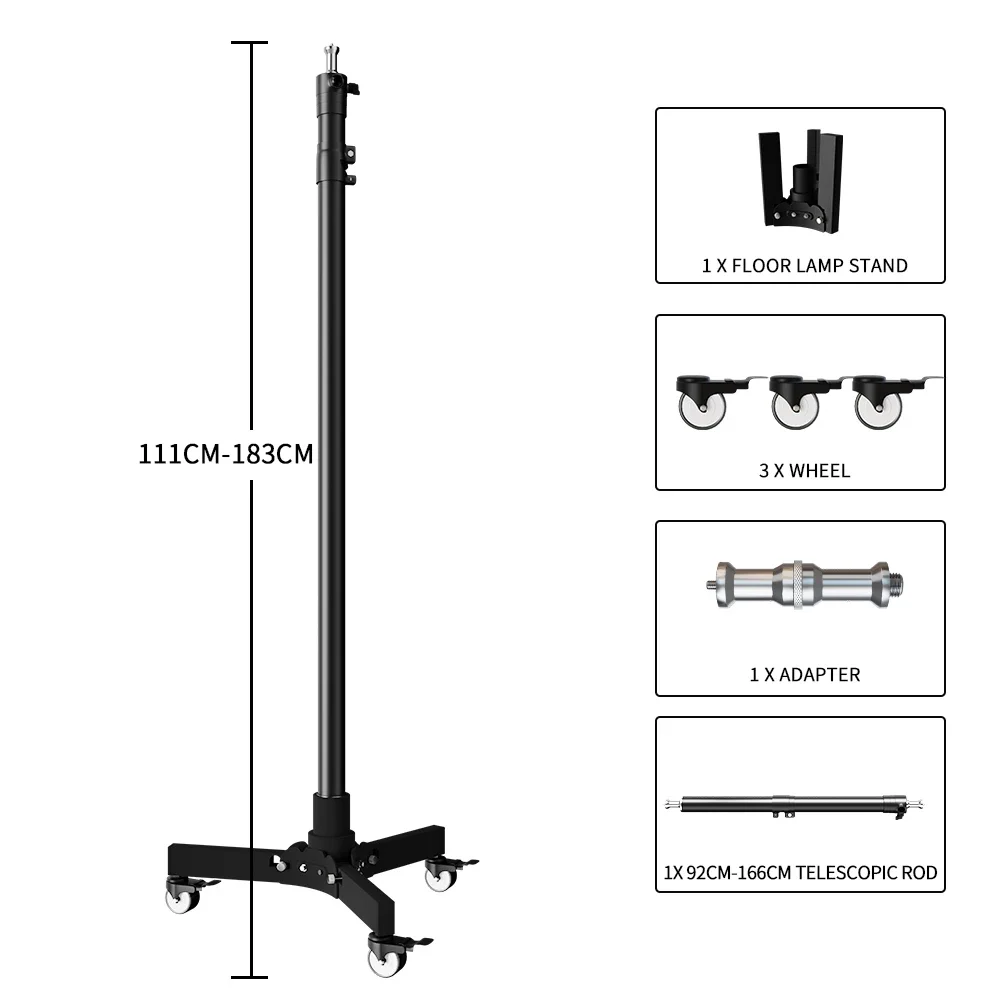
The most elegant solution to arc lamp stability comes from manufacturers who integrate appropriate weighting directly into the lamp’s design. These purpose-built bases combine aesthetic considerations with the physics requirements for stability, resulting in bases that are both beautiful and functional.
Marble and Stone Bases
Marble bases represent perhaps the most classic and visually striking solution to the arc lamp stability challenge:
- Weight Range: Typically 20-30 pounds (9-14 kg)
- Aesthetic Appeal: High-end, luxurious appearance with natural variations
- Stability: Excellent weight-to-size ratio with natural vibration dampening
- Considerations: More expensive, can chip or crack if dropped
Stone bases, including marble, granite, and other natural materials, provide substantial weight in a relatively compact footprint. The natural variations in the stone make each lamp unique while providing the necessary counterbalance to the extended arm.
Metal Base Designs
Cast iron and steel plate bases offer alternative approaches to the weighting challenge:
- Weight Range: 15-25 pounds (7-11 kg)
- Aesthetic Appeal: Industrial, contemporary appearance
- Stability: Good weight distribution with durability
- Considerations: Can dent floors if not padded, sometimes prone to scratching
Metal bases often feature slimmer profiles while maintaining adequate weight. They typically complement modern or industrial design schemes and can be finished in various ways to match other room elements.
Composite and Filled Bases
Many contemporary arc lamps feature hollow bases filled with stabilizing materials:
- Weight Range: 15-40 pounds (7-18 kg) depending on filling
- Aesthetic Appeal: Clean, minimalist designs possible
- Stability: Can be customized based on lamp dimensions
- Considerations: May deteriorate over time if filling shifts or settles
These designs allow for creative shapes and finishes while maintaining necessary weight. Common fillings include concrete, sand, steel shot, or other dense materials encased in metal, plastic, or wooden shells.
The comprehensive guide to arc lamp base designs provides deeper insights into how manufacturers balance aesthetic considerations with functional requirements. The base diameter typically ranges from 16-24 inches (41-61 cm), with larger diameters allowing for slightly reduced weight due to improved leverage distribution.
When selecting an arc lamp, examining both the weight and distribution of the base provides valuable insight into the lamp’s overall quality and stability. Premium lamps invest significantly in their base designs, recognizing that this foundation determines both safety and longevity.
Aftermarket Base Weight Solutions
Even well-designed arc lamps sometimes benefit from additional stabilization, particularly when placed on uneven surfaces or in high-traffic areas. The aftermarket offers various solutions designed specifically to enhance arc lamp stability without compromising aesthetics.
Commercial weight products designed for lamps typically fall into several categories:
- Disc-shaped base weights: Thin, heavy plates designed to slide under existing lamp bases, adding 5-15 pounds (2.3-6.8 kg) while remaining largely invisible
- Weighted base covers: Decorative elements that conceal weights while complementing the lamp’s design
- Lamp base loaders: Specially formulated weighted materials that can be added to hollow bases
- Furniture anchoring systems: Devices that physically secure lamps to walls, floors, or furniture
These products typically range from $25-$75 depending on weight and design quality. Most use materials like steel or lead that provide maximum weight with minimum volume, allowing them to remain unobtrusive.
When considering aftermarket weighting solutions, compatibility becomes a key concern. Factors to consider include:
- The shape and dimensions of your existing lamp base
- The amount of additional weight needed (based on assessment)
- Floor protection requirements
- Aesthetic impact of the solution
For particularly tall or large arc floor lamps, aftermarket solutions provide cost-effective stability enhancements without replacing the entire fixture. Some products are designed to be temporary and removable, making them ideal for rental situations where permanent modifications aren’t practical.
Commercial solutions typically offer more polished appearances than DIY approaches while requiring less effort to implement. They represent a middle ground between accepting an unstable lamp and investing in an entirely new fixture with better integrated weighting.
DIY Methods for Weighting Arc Lamp Bases
For those comfortable with hands-on solutions, several DIY approaches offer effective ways to improve arc lamp stability without significant expense. These methods are particularly valuable for vintage lamps, budget models, or situations where commercial solutions aren’t readily available.
Filling Hollow Bases
Many arc lamps feature hollow metal or plastic bases that can be filled with weighting materials:
- Sand: Approximately 100 pounds (45 kg) per cubic foot, easily available, and conforms to irregular spaces
- Concrete: About 150 pounds (68 kg) per cubic foot, provides permanent weight but can’t be removed
- Lead shot or steel BBs: Nearly 300 pounds (136 kg) per cubic foot, maximum weight but more expensive
- Water: 62.4 pounds (28.3 kg) per cubic foot, easily added/removed but risk of leaking
The filling method requires identifying or creating an access point, carefully adding material, and properly sealing the base to prevent leakage.
External Weighting Techniques
When filling isn’t possible, external weights can be effectively concealed:
- Exercise weights: Standard barbell plates can be painted or covered to match lamp aesthetics
- Decorative stone: Attractive rocks can provide both weight and visual interest
- Hidden sandbags: Fabric pouches filled with sand can be positioned against the base
- Furniture arrangement: Strategic positioning of other furniture pieces can help secure the lamp
Many homeowners get creative with methods for stabilizing arc lamp bases by incorporating the weight into their decor. For example, a small stack of art books or a decorative box positioned on the base’s edge opposite the arc can provide counterweight while enhancing the room’s design.
The key to successful DIY weighting is balancing effectiveness with aesthetics. The goal is to add sufficient weight to ensure stability without creating an eyesore or making the lamp difficult to reposition when needed. With thoughtful implementation, DIY solutions can be virtually invisible while providing excellent stability.
Assessing Your Arc Lamp’s Stability Needs
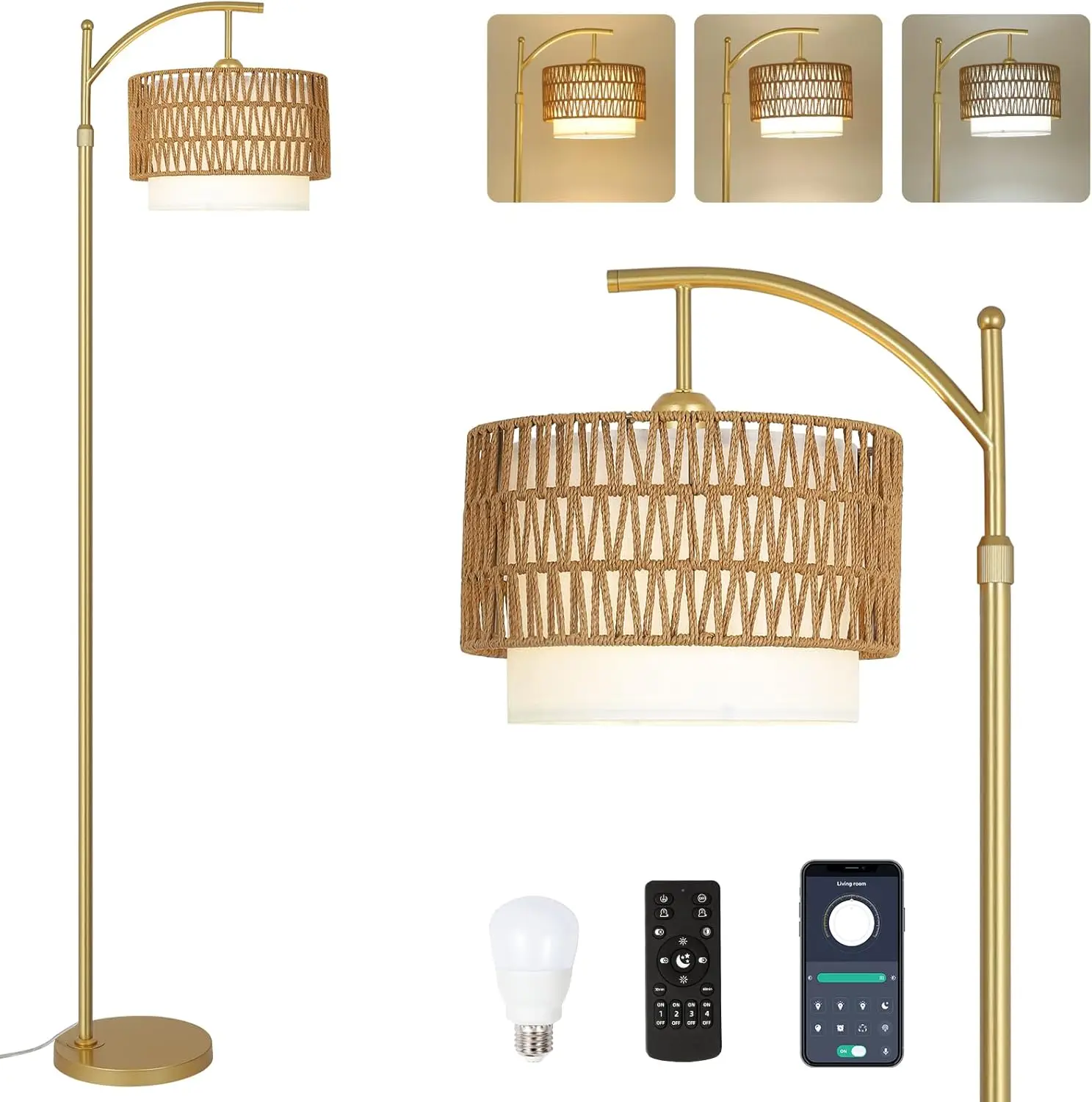
Before selecting a weighting solution, it’s important to determine exactly how much additional stability your specific lamp requires. This assessment helps avoid both inadequate solutions that leave safety risks and excessive weighting that creates unnecessary bulk or expense.
Basic Stability Calculation
A simplified approach to calculating base weight requirements:
- Measure the horizontal reach of your lamp (distance from center of base to light source)
- Weigh the lamp head or estimate its weight (typically 2-5 pounds/0.9-2.3 kg)
- Multiply these figures to determine the torque force
- Divide by the radius of your base to find minimum weight needed
As a general rule, many lamp designers recommend:
* For every 10 inches (25 cm) of horizontal reach
* Add approximately 5-8 pounds (2.3-3.6 kg) of base weight
* Additional weight for carpet or uneven surfaces
Stability Testing
To test if your lamp has adequate stability:
- Place the lamp on its intended surface
- Gently push the arc from different directions, noting any tendency to tip
- Test stability when the arm is positioned at different angles
- Consider how the lamp responds to typical household activities (vacuuming nearby, pets running past)
Different flooring surfaces significantly impact stability requirements. Carpets and rugs may require 20-30% more base weight than hard surfaces due to their uneven, yielding nature. Similarly, slightly uneven floors create leverage challenges that require additional compensation.
The complete guide to stabilizing various floor lamp bases provides detailed assessment techniques for different lamp styles. Remember that adequate stability isn’t just about preventing complete tipping—it’s also about minimizing wobbling and movement that can loosen components or create annoying lamp sway during normal household activities.
This assessment stage is critical because it determines whether your lamp needs modest reinforcement or significant intervention. The results directly inform which solutions from previous sections will provide optimal results for your specific situation.
Step-by-Step Guide: Filling Hollow Lamp Bases
For lamps with hollow bases that can be accessed, filling with weighting material offers an elegant, invisible solution to stability problems. This approach maintains the lamp’s original appearance while significantly improving its safety and stability.
Materials Needed:
- Weighting material (sand, steel shot, or concrete mix)
- Funnel or paper cone
- Screwdriver or appropriate tool to access base
- Sealant appropriate for base material
- Protective covering for floor
- Gloves and dust mask
Step-by-Step Process:
Preparation
* Unplug the lamp and place it on a protected surface
* Identify the access point (typically a screw cap or removable base plate)
* Remove any electrical components that might be damaged by filling materialCreating Access
* Carefully remove the access point using appropriate tools
* If no existing access exists, consider creating one in an inconspicuous location
* Ensure the opening is large enough to add filling material but not compromise structureAdding Weight
* Place funnel in the opening
* Slowly add filling material, tapping occasionally to ensure complete filling
* Leave approximately 1 inch (2.5 cm) of space at the top for sealantSealing
* Clean the opening area thoroughly
* Apply appropriate sealant based on base material
* Allow proper curing time before moving the lamp
The choice of filling material affects both weight and long-term stability. Sand provides about 100 pounds (45 kg) per cubic foot and works well but can shift over time. Concrete creates a permanent solution at about 150 pounds (68 kg) per cubic foot but cannot be removed later. Steel shot offers maximum weight (nearly 300 pounds/136 kg per cubic foot) but at higher cost.
This method works particularly well with black arc floor lamps where the base material helps conceal any evidence of modification. When properly executed, filling creates a stable lamp that maintains its original aesthetic while eliminating tipping hazards.
Installing External Weights Effectively
When internal filling isn’t possible or sufficient, external weights provide a practical alternative. The key to success lies in both securing and concealing these weights effectively.
Step-by-Step External Weighting:
Assess Weight Placement
* Identify the optimal position (typically opposite the arc direction)
* Ensure the weight won’t interfere with electrical components
* Determine whether weight should be permanent or removableSelect Appropriate Weights
* Standard exercise weights (5-10 pound/2.3-4.5 kg plates work well)
* Purpose-made furniture weights
* Heavy decorative objects that complement the lamp’s designSecure Weights Properly
* For permanent installation, use appropriate adhesive for base material
* For removable solutions, create fabric pouches or decorative covers
* Ensure weight cannot shift during normal lamp use or cleaningConceal the Modification
* Position furniture to hide external weights
* Use decorative covers that complement room decor
* Consider incorporating weight into other functional items (bookends, planters)
Creative concealment options include:
* Custom fabric covers that match existing decor
* Small stacks of books positioned strategically against the base
* Decorative boxes or containers that hold weights while enhancing aesthetics
* Repositioning the lamp near furniture that visually incorporates the weighting solution
For oversized floor lamps, external weighting often provides the substantial counterbalance needed without requiring modification to the lamp itself. This approach proves especially valuable for rental properties or situations where preserving the original condition of an expensive or antique lamp is important.
The most successful external weighting solutions become virtually invisible parts of your decor, with visitors never realizing they serve a functional purpose beyond their aesthetic contribution to the space.
Repairing and Reinforcing Damaged Bases
Over time, arc lamp bases may develop structural issues that compromise stability. Identifying and addressing these problems extends lamp lifespan while maintaining safety.
Common Base Damage Patterns:
- Crumbling concrete or plaster filling in older lamps
- Separation between base and vertical support pole
- Cracked or warped base plates
- Corrosion in metal components affecting structural integrity
- Loose internal weights that shift and create imbalance
Repair Techniques:
For deteriorating concrete or plaster:
1. Remove loose material completely
2. Clean interior thoroughly
3. Mix new concrete or epoxy filler
4. Refill base completely
5. Allow proper curing time before use
For weakened connections between base and stem:
1. Disassemble the connection point
2. Clean all contact surfaces
3. Apply appropriate metal epoxy or reinforcement plates
4. Reassemble with new hardware if necessary
5. Test stability before regular use
Warning signs that indicate serious structural issues include:
* Visible cracks or deformation in the base
* Unusual movement or wobbling at connection points
* Metallic sounds when the lamp is moved (indicating broken internal components)
* Progressive worsening of stability despite previous interventions
The decision to repair versus replace should consider both safety and economics. When repair costs approach 40-50% of replacement value, or when structural integrity is seriously compromised, replacement often provides the safer option. However, for vintage or designer lamps, professional restoration may preserve both value and function.
These repair techniques complement the strategies outlined in guides on preventing floor lamps from leaning, addressing both the weighting and structural aspects of lamp stability.
Optimal Placement for Maximum Stability
Beyond physical weighting, strategic placement significantly impacts arc lamp stability and safety. Thoughtful positioning can enhance base effectiveness while reducing tipping risks.
Surface Considerations:
- Hard surfaces (wood, tile): Provide maximum stability but may require protective pads to prevent scratches
- Carpeted surfaces: Reduce stability by 20-30%; compensate with additional weight or larger base footprint
- Uneven floors: Place shims under specific points of the base to create level foundation
- Area rugs: Ensure the entire base rests firmly on the same surface type
Strategic Positioning:
- Place arc lamps away from high-traffic walkways where bumping is likely
- Position the arc toward walls rather than open room spaces when possible
- Consider corner placement where two walls can help block tipping directions
- Keep at least 16 inches (41 cm) between arc lamps and frequently used furniture
Cord Management for Safety:
- Route power cords away from walkways
- Never place cords under rugs (fire hazard)
- Use cord covers or guides to prevent tripping
- Ensure cords don’t create pulling hazards that could tip the lamp
Additional stabilizing accessories like non-slip pads and furniture anchors provide extra security without visible modification. These simple additions can significantly improve stability without affecting the lamp’s appearance.
The comprehensive strategies detailed in guides about preventing arc lamps from tipping emphasize that proper placement works in conjunction with adequate weighting—neither approach alone provides optimal results. By combining appropriate base weight with strategic placement, you maximize both safety and functionality.
Where to Find Specialized Weighted Base Solutions
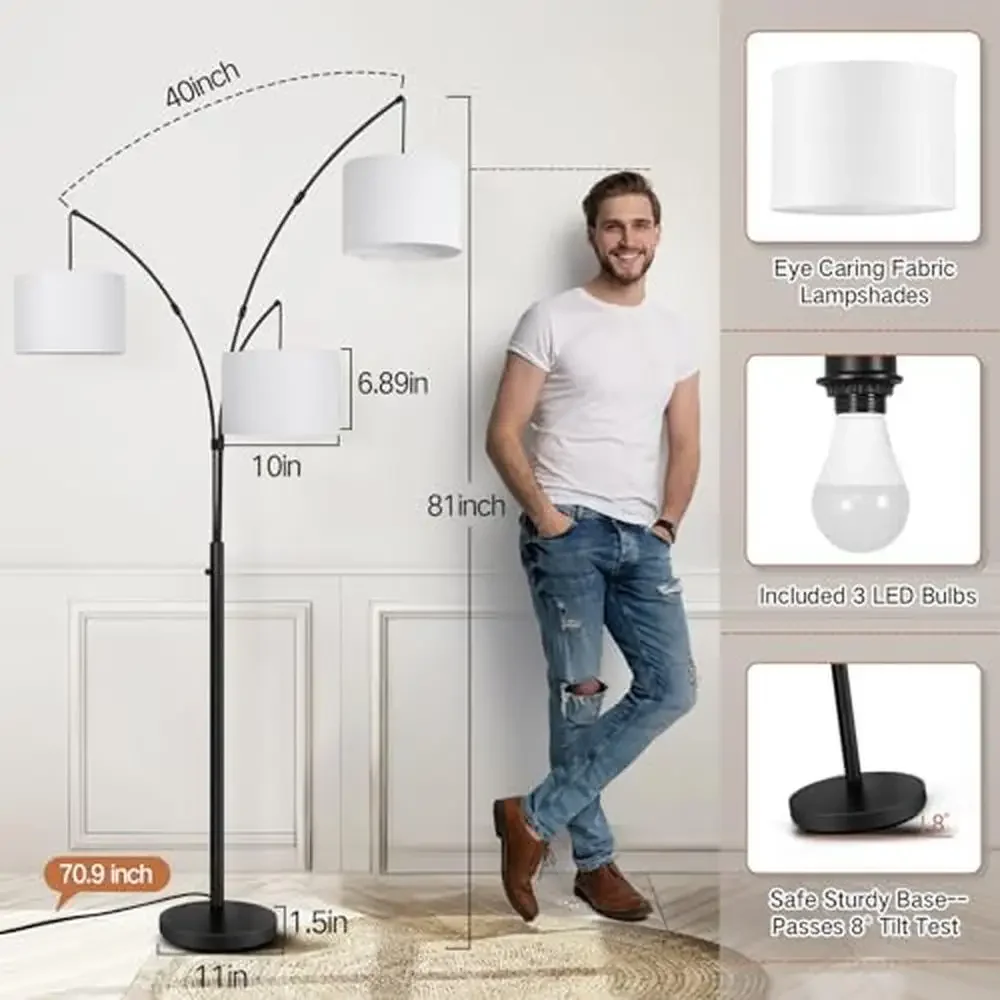
Finding the right weighting solutions requires knowing where to look beyond standard retail channels. Whether you need replacement parts, aftermarket weights, or completely new lamps with adequate stability, several specialized sources offer appropriate options.
Specialty Retailers:
- Lighting specialty stores: Often carry replacement bases and weighting accessories
- Home improvement centers: Offer basic weighting materials and some lamp repair parts
- Restoration hardware suppliers: Specialize in components for vintage or antique lamps
- Custom lighting fabricators: Can create bespoke weighted bases for unique lamps
Online Marketplaces:
- Dedicated lighting parts websites
- Specialty hardware suppliers
- Maker marketplaces featuring custom solutions
- Auction sites for vintage or discontinued parts
When shopping for new arc lamps, look for these stability indicators:
- Base weight listed in product specifications (16+ pounds/7.3+ kg minimum)
- Base diameter proportional to arm reach (wider is generally better)
- Customer reviews specifically mentioning stability
- Materials known for density (marble, stone, heavy metals)
- Construction details about internal weighting
Contemporary Arc Floor Lamp, Large Arc Floor Lamp, Oversized Arched Floor Lamp
$460.63 Select options This product has multiple variants. The options may be chosen on the product pageAdjustable Arc Floor Lamp, Bronze Arc Floor Lamp
Price range: $440.95 through $558.52 Select options This product has multiple variants. The options may be chosen on the product pageBrass Arc Floor Lamp, Contemporary Arc Floor Lamp, LED Arc Floor Lamp
Price range: $490.72 through $522.04 Select options This product has multiple variants. The options may be chosen on the product pageChrome Arc Floor Lamp, LED Arc Floor Lamp
Price range: $304.95 through $1,210.40 Select options This product has multiple variants. The options may be chosen on the product pageContemporary Arc Floor Lamp, Large Arc Floor Lamp, Marble Base Arc Floor Lamp
$224.94 Select options This product has multiple variants. The options may be chosen on the product pageContemporary Arc Floor Lamp, Silver Arc Floor Lamp
$459.99 Select options This product has multiple variants. The options may be chosen on the product page
At Interior Ivy, we carefully evaluate the stability of all our oversized arched floor lamps to ensure they provide both the dramatic visual impact and practical stability our customers expect. Our product descriptions include base specifications to help you make informed decisions about which lamps will work best in your specific environment.
For DIY solutions, hardware stores typically offer materials like sand, concrete mix, and steel weights at reasonable prices. The investment in proper weighting materials represents a small fraction of the lamp’s overall cost while significantly extending its useful life.
Safety Best Practices for Arc Lamp Use
Even properly weighted arc lamps benefit from ongoing attention to safety. Implementing these best practices helps prevent accidents and extends the functional lifespan of your lighting investment.
Regular Maintenance Checks:
- Monthly: Inspect base for signs of damage or deterioration
- Quarterly: Check all connection points for tightness
- Seasonally: Reassess stability when changing room arrangements
- Annually: Conduct thorough inspection of electrical components
Simple Stability Tests:
- Gently push the lamp arm in different directions to check for movement
- Ensure the base remains firmly planted when the arm is adjusted
- Check that all connections remain tight and secure
- Verify that any added weights remain properly positioned
Household Considerations:
- Communicate lamp fragility to children and guests
- Consider temporary lamp removal during parties or events with many visitors
- Be especially vigilant during holiday decorating when room arrangements change
- Use extra caution when cleaning around or under arc lamps
Warning signs that require immediate attention include unusual wobbling, visible cracks in the base, loosening of the vertical support, or any electrical issues such as intermittent lighting or sparking.
Special considerations apply when ceiling height affects arc lamp selection, as taller lamps generally require proportionally heavier bases. The relationship between lamp height and ceiling clearance creates both aesthetic and practical concerns that influence optimal placement.
By maintaining awareness of these safety practices, you’ll enjoy both the dramatic visual impact and functional lighting that quality arc lamps provide, without compromising on household safety.
Common Questions About Arc Lamp Stability
How much should an arc lamp base weigh?
The minimum base weight depends on your lamp’s dimensions. Generally, the base should weigh at least 15-20 pounds (6.8-9 kg) for standard arc lamps, with an additional 2-3 pounds (0.9-1.4 kg) for each additional foot of arm length or height. Oversized lamps may require 30+ pounds (13.6+ kg) for proper stability.
Can I use my arc lamp on carpeted floors?
Yes, but carpet reduces stability by absorbing and shifting under weight. Increase base weight by approximately 25% for carpeted areas or consider using a rigid base plate beneath the lamp to distribute weight more effectively.
Are marble bases better than metal bases?
Marble bases typically provide better stability due to their greater density and weight for size. However, well-designed metal bases with appropriate internal weighting can perform equally well while offering different aesthetic options and often at lower prices.
My vintage arc lamp is wobbling. Should I replace it?
Not necessarily. Many vintage lamps can be successfully restored with proper base repair or weighting. First, determine if the issue is in the base weight, the connection points, or the internal structure. Often, simple repairs or weight additions can restore stability without sacrificing the lamp’s character or value.
How do I weight a lamp with an unusual base shape?
For non-standard base shapes, consider custom-cut weight plates that follow the base contour or strategic placement of multiple smaller weights. External weights can be effectively concealed with decorative covers custom-made to complement your lamp’s design.
Will adding weight affect my lamp’s adjustability?
Properly added weight shouldn’t affect a lamp’s intended adjustability. However, excessive weight can stress joints and adjustment mechanisms. Follow manufacturer guidelines for weight limits and ensure added weights don’t interfere with moving parts or adjustment points.
How do I safely transport a weighted arc lamp?
Always disassemble arc lamps for moving when possible. If disassembly isn’t an option, remove any aftermarket weights, secure the arm close to the vertical support, and have at least two people handle the lamp—one supporting the base and one guiding the arm to prevent bending or stress damage.
For those interested in exploring different styles, our collection of metal finish arc floor lamps offers various base designs that balance aesthetic considerations with proper stability requirements.

